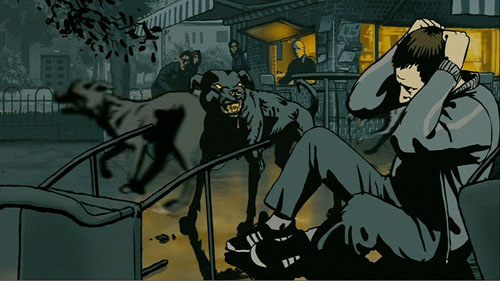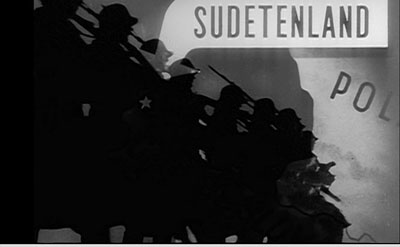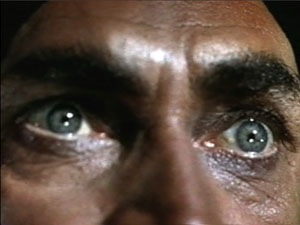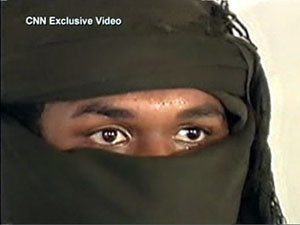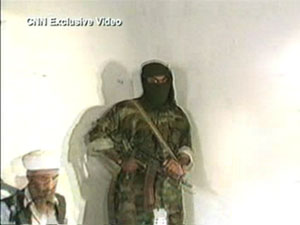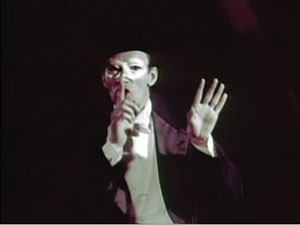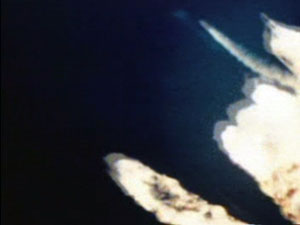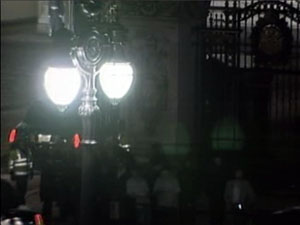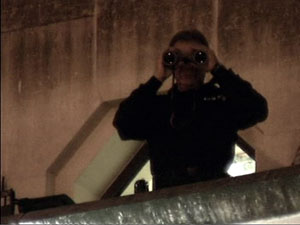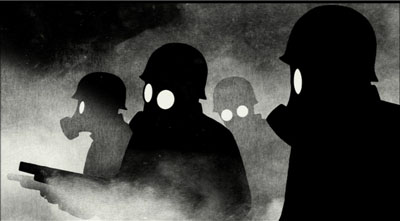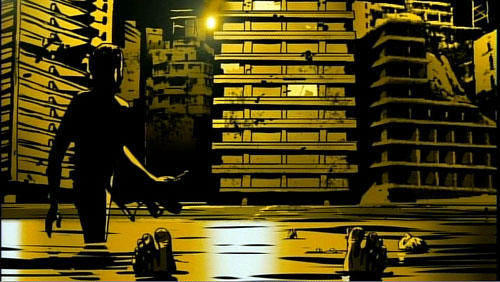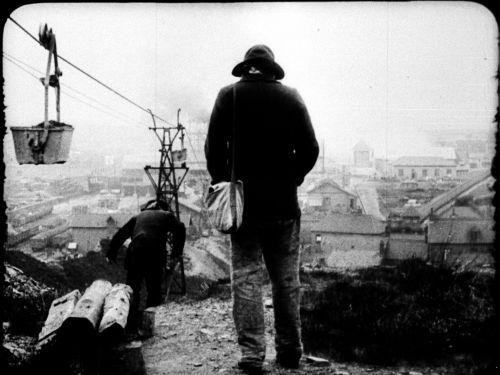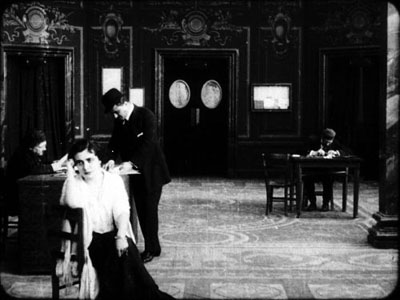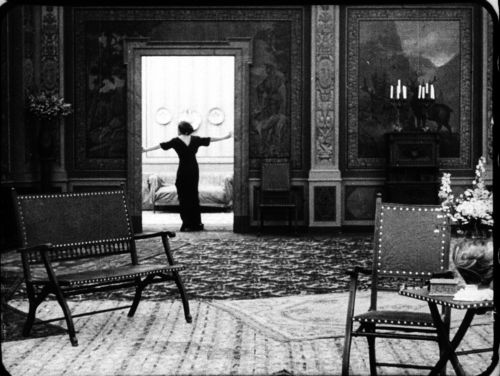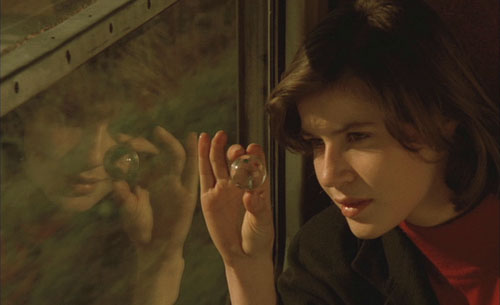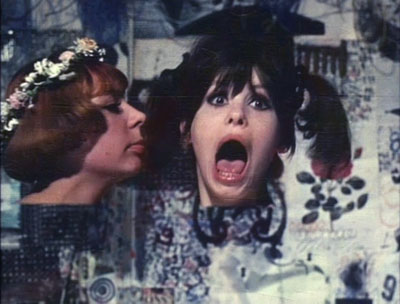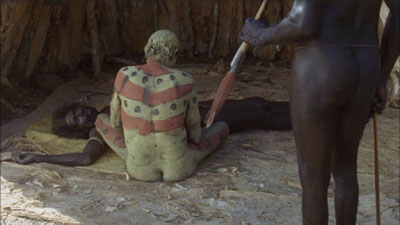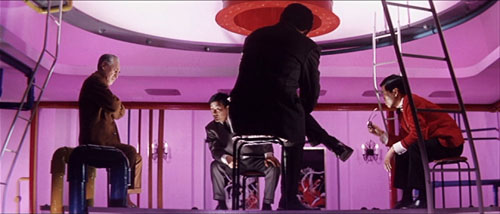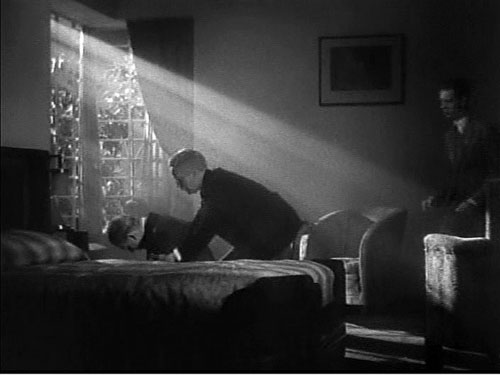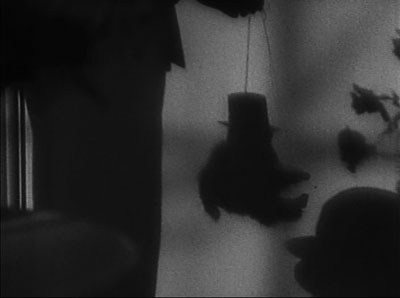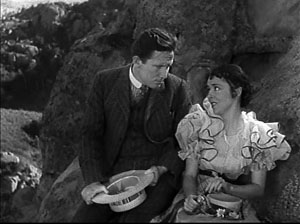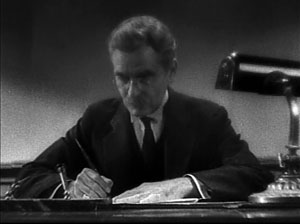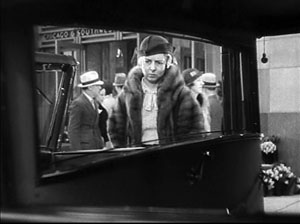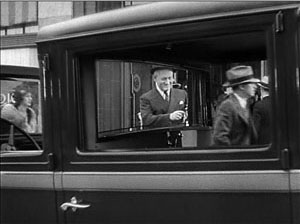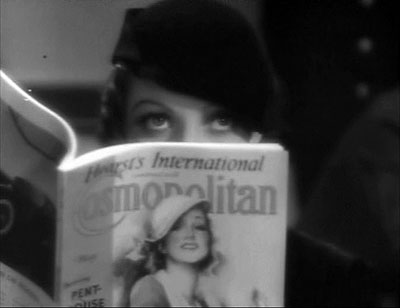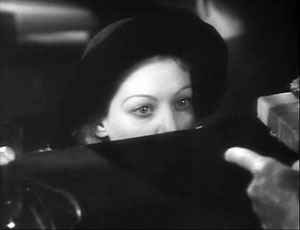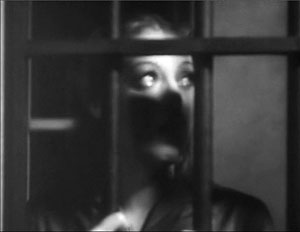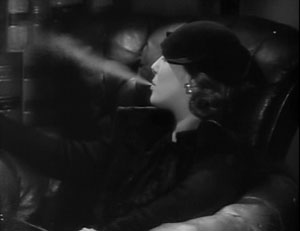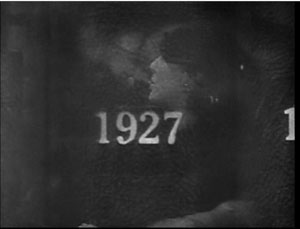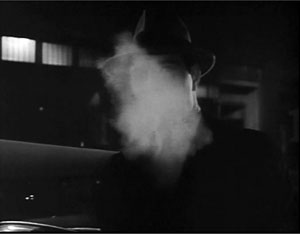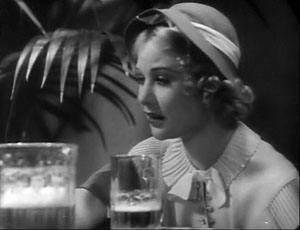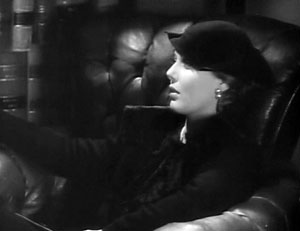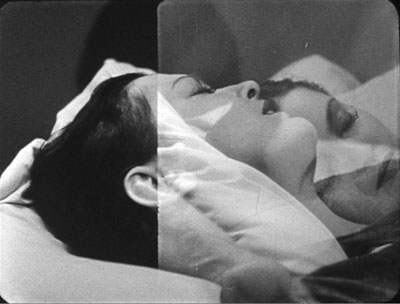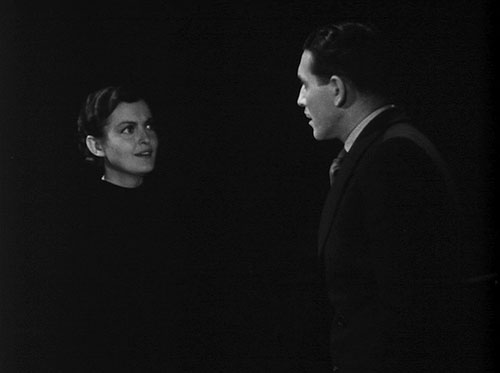Archive for the 'Film scholarship' Category
Showing what can’t be filmed
DB, again:
People tend to think that documentary films are typified by two conditions. First, the events we see are unstaged, or at least unstaged by the filmmaker. If you mount a parade, the way that Coppola staged the Corpus Christi procession in The Godfather Part II, then you aren’t making a documentary. But if you go to a town that is holding such a procession and shoot it, you are making a doc—even though the parade was organized to some extent by others. Fiction films stage their events for the camera, but documentaries, we tend to think, capture spontaneous happenings.
Secondly, in a documentary the camera is seizing those events photographically. The great film theorist André Bazin saw cinema’s defining characteristic as its capacity to record the actual unfolding of events with little human intervention. All the other arts rely on human creation at a basic level: the novelist selects words, the painter chooses colors. But the photographer or filmmaker employs a machine that impassively records what is happening in front of it. “All the arts are based on the presence of man,” Bazin writes; “only photography derives an advantage from his absence.” This isn’t to say that cinema can’t be artful, only that it offers a different sort of creativity than we find in the traditional arts. The filmmaker works not with pure imaginings but obstinate chunks of actual time and space.
Given these two intuitions, unstaged events and direct recording of them, it would seem impossible to consider an animated film as a documentary. Animated films consist of almost completely staged tableaus—drawings, miniatures, clay, even food or wood shavings (in the works of Jan Svankmajer). And animated movies offer no recording in Bazin’s sense of capturing the flow of real time and space. These films are made a frame at a time, and the movement we see onscreen doesn’t derive from movement that occurred in reality. And of course you can make an animated film without a camera, for instance by painting directly on film or assembling computer-generated imagery.
Recently, however, we’ve been faced with animated films that claim documentary validity. How is this possible? Maybe we need to rethink our assumptions about what documentary is.
In certain types of documentaries, especially those in the Direct Cinema or cinéma vérité traditions, the assumption that we’re seeing spontaneously occurring events holds good. But a documentary can consist wholly of staged footage. Think back to those grade-school educational shorts showing a tour of a nuclear power plant. Every awkward passage of dialogue recited by the hard-hatted, white-coated supervisor was scripted. The whole show was planned and rehearsed, but that doesn’t detract from the factual content of the film.
Go further. Recall those attack maps that are shown in war films, tracing the progress of an army through enemy terrain. Now imagine an entire film made of those animated maps. The maps might even be enhanced with a few cartoon images, as in the above shot from one of the Why We Fight films. The film would be entirely designed, presenting no spontaneous reality being captured by the camera. Yet it would plainly be a documentary, telling us that, say, the Germans marched into the Sudetenland in 1938 and proceeded on to Poland. So we don’t need photographic recording of actual events to count a film as a documentary either. Both the staging and the recording conditions don’t have to be present for a film to count as a documentary.
I’m not saying that the claims advanced in my nuclear-power film or my attack-map movie would necessarily be accurate. They might be erroneous or inconclusive or false. But that possibility looms for any documentary. The point is that the films, presented and labeled as documentaries, are thereby asserting that the claims and conclusions are true.
Film theorist Noël Carroll defines documentary as the film of “purported fact.” Carl Plantinga makes a similar point in saying that documentaries take “an assertive stance.” Both these writers argue that we take it for granted that a documentary is claiming something to be true about the world. The persons and actions are to be taken as representing states of affairs that exist, or once existed. This is not something that is presumed by The Gold Rush, Magnificent Obsession, or Speed Racer. These films come to us labeled as fictional, and they do not assert that their events and agents ever existed.
This isn’t just a case of a professor stating something obvious in a fancy way. Once we see documentary films as tacitly asserting a state of affairs to be factual, we can see that no particular sort of images guarantees a film to be a doc.
Take the remarkable documentaries made by Adam Curtis. These are in a way very old-fashioned. Blessed with a voice whose authoritative urgency makes you think that at last the veils are being ripped away, Curtis mounts detailed arguments framed as historical narratives. Freudian theory shaped the emergence of public relations, which was in turn exploited not just by business but by government (Century of the Self). Islamic fundamentalism grew up intertwined with US Neoconservatism, both being reactions to perceptions that the West was becoming heartlessly materialistic (The Power of Nightmares). Mathematical game theory came to form politicians’ dominant conception of human behavior and civic community (The Trap). The almost uninterrupted flow of Curtis’s voice-over commentary could be transcribed and published as a piece of nonfiction. True, there are some interpolated talking heads, but those experts’ statements could be printed as inset quotations.
What’s particularly interesting is that Curtis’ rapid-fire declamation accompanies images that often seem not to illustrate it, or at least not very firmly. Like the found footage in the preacher’s sermon “Puzzling Evidence” in True Stories, Curtis’ images are enigmatic, tangential, or metaphorical.
Here are a few seconds from the start of The Power of Nightmares. Eyes are staring upward, as if possessed.
We hear: [Our politicians] say that they will rescue us from dreadful . . .
The eyes are replaced by a shot of a man wearing a cowl, and as this image zooms back the commentary continues.
. . . dangers that we cannot see and do not . . .
Cut to a magician or mime demanding silence.
. . . understand.
Cut to rockets being fired.
And the greatest danger . . .
Cut to a procession of cars, seen from above, rounding a corner into a government compound at night.
. . . of all is international terrorism.
Cut to shot of security agent staring at us.
The ominous, not to say paranoid, tenor of the sequence is aided by the unexpected juxtapositions. For instance, you’d think that the shot of the iconic terrorist (anonymous, with automatic weapon) would be synchronized with the final line of the commentary, referring to “international terrorism.” Instead the commentary links the mention of terrorism to an image of government deliberation, and then to an image of surveillance (aimed at us, but also perhaps suggesting the previous high-angle shot was the spy’s POV). The wild-eyed close-up might belong to a terrorist, but is accompanied by claims about rescuing us from fearsome threats, so the eyes could also belong to someone panicked–especially since they contrast immediately with the sober eyes of the gunman in the cowl. Perhaps the first shot represents the fearful public ready to be led by the politicians playing on fear. And the insert shot of the mime becomes sinister but also comic, perhaps debunking the official position that our dangers are unseen and unknowable. In all, the sequence bubbles with associations that are less fixed and more ambiguous than we’re likely to find in a more orthodox documentary, like Jarecki’s Why We Fight.
My point isn’t to analyze the image/ sound relations in Curtis’s work, a task that probably demands a whole book. (This sequence takes a mere eleven seconds.) I simply want to propose that regardless of what pictures Curtis shows, his films are documentaries in virtue of a soundtrack constructed as a discursive argument that makes truth claims. The picture track often works on us less as supporting evidence than as a stream of associations, the way metaphors or analogies give thrust to a persuasive speech.
Just as we could have an account of Germany’s 1938 invasion of Czechoslovakia presented in cartoon form, we could imagine The Power of Nightmares illustrated with political cartoons. Once we’ve pried the image track loose from the assertions on the soundtrack, anything goes.
One example much on our minds now is Waltz with Bashir. Ari Folman interviews former Israeli soldiers. But instead of using film footage of their conversations and, say, still photos of the events in Lebanon they took part in, he provides (until the final sequence) drawings a bit in the Eurocomics mold of Tardi or Marc-Antoine Mathieu. The result takes the form of a memoir, admittedly. But in both literature and cinema, memoir is a nonfiction genre.
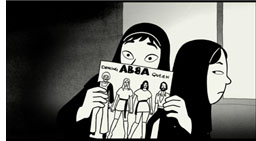 Another memoir supports the point. Marjane Satrapi’s autobiographical graphic novels, Persepolis and Persepolis 2, assert factual claims about her life. The claims are presented as drawings and texts rather than simply as texts, but that doesn’t change the fact that she presents agents and actions purported to have existed. True, on film the people whom she remembers are represented through voice actors speaking lines she wrote. But as with written memoirs (especially those that claim to remember conversations taking place fifty years ago), we can always be skeptical about whether the events presented actually took place.
Another memoir supports the point. Marjane Satrapi’s autobiographical graphic novels, Persepolis and Persepolis 2, assert factual claims about her life. The claims are presented as drawings and texts rather than simply as texts, but that doesn’t change the fact that she presents agents and actions purported to have existed. True, on film the people whom she remembers are represented through voice actors speaking lines she wrote. But as with written memoirs (especially those that claim to remember conversations taking place fifty years ago), we can always be skeptical about whether the events presented actually took place.
Turning Satrapi’s published memoir into an animated film did not change its status as a documentary. If we had contrary evidence, we could charge her with fibbing about her family life, her rebelliousness, or her life in Europe. But we’d be questioning the presumptive assertions the film makes, not the fact that it is drawn and dubbed rather than photographed from life.
We’re tempted to see the animation in these films as adding a level of distance from reality. We’re so used to fly-on-the-wall documentaries that we may be suspicious of the cobra-like caricatures of the female teachers in Persepolis or the hallucinatory dawn bombardment in Bashir. Yet animation can show things, like the Israeli veterans’ dreams, that lie outside the reach of photography. And the artificiality doesn’t dilute the claims about what the witnesses say happened any more than does purple prose in an autobiography. In fact, the stylization that animation bestows can intensify our perception of the events, as metaphors and vivid imagery in a written memoir do.
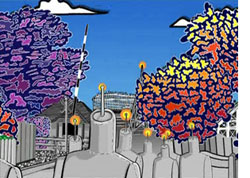 I realize I’m pointing toward a slippery slope here. Strip off the image track from Aardman‘s Creature Comforts and you have impromptu recordings of ordinary people talking about their lives. Those monologues could have been accompanied by documentary-style talking heads. Does that make Creature Comforts a documentary? I’d say not because the film doesn’t come to us labeled that way; it’s presented as comic animation using found soundtracks (like the movie based on the Lenny Bruce routine Thank You Mask Man). Then there are Bob Sabiston‘s rotoscoped films like Waking Life and The Even More Fun Trip, recently released on Wholphin no. 7. The latter (left) takes another documentary form, the home movie, as the basis for its animation. This seems to me an instance where the documentary category has the edge, but it’s a surely a borderline case.
I realize I’m pointing toward a slippery slope here. Strip off the image track from Aardman‘s Creature Comforts and you have impromptu recordings of ordinary people talking about their lives. Those monologues could have been accompanied by documentary-style talking heads. Does that make Creature Comforts a documentary? I’d say not because the film doesn’t come to us labeled that way; it’s presented as comic animation using found soundtracks (like the movie based on the Lenny Bruce routine Thank You Mask Man). Then there are Bob Sabiston‘s rotoscoped films like Waking Life and The Even More Fun Trip, recently released on Wholphin no. 7. The latter (left) takes another documentary form, the home movie, as the basis for its animation. This seems to me an instance where the documentary category has the edge, but it’s a surely a borderline case.
Animated documentaries are likely to remain pretty far from our prototype of the mode. Still, we should be grateful that even imagery that seems to be wholly fictional—animated creatures—can present things that really happen in our world. This mode of filmmaking can bear vibrant witness to things that cameras might not, or could not, or perhaps should not, record on the spot.
André Bazin’s arguments for the documentary basis of cinema are set out in “The Ontology of the Photographic Image,” in What Is Cinema? ed. and trans. Hugh Gray (Berkeley: University of California Press, 1967), 9-16. Noël Carroll’s argument that documentaries are framed as presenting “purported fact” can be found in Theorizing the Moving Image (Cambridge: Cambridge University Press, 1996), 224-259. On the “assertive stance” of documentaries, see Carl Plantinga, Rhetoric and Representation in Nonfiction Film (Cambridge: Cambridge University Press, 1997), 15-25. Errol Morris interviews Adam Curtis here. Thanks to Mike King for pointing me toward The Even More Fun Trip.
PS 10 March: Harvey Deneroff writes:
Very much enjoyed your post on animated documentaries, a topic of some interest to and often discussed in the animation studies community. There was a panel on it during last year’s Society for Animation Studies conference and there will also be one at this year’s as well.
Two recent Oscar recipients for Best Animated Short Subject are also documentaries: Chris Landreth’s wonderful computer animated Ryan (produced by the NFB about animator Ryan Larkin, and features a lot of talking heads) and John Canemaker’s The Moon and the Son: An Imagined Conversation, which is about Canemaker’s father and mixes animation with home movies and photographs.
At least two winners in the Oscar Documentary Short Subject category were largely animated: Chuck Jones’ So Much for So Little (WB, 1949, which I believe was made for the US Public Health Service) and Norman McLaren’s Neighbours. The Story of Time, a 1951 British documentary which featured stop motion animation was nominated in the same category.
Also, the International Leipzig Festival for Documentary and Animated Film includes a section for animated documentary films.
Thanks to Harvey for this. I’m not sure I’d categorize Neighbours as a doc, but it’s a long time since I’ve seen it. On Harvey’s site he also has a note quoting Ari Folman on the difficulty of funding animated docs. And thanks to Ryan Kelly and Pete Porter for reminding me of Winsor McCay’s Sinking of the Lusitania from 1918.
Acting up
Germinal (1913).
DB here:
Film performance is notoriously difficult to analyze. We don’t lack zesty celebrations of actors; I think especially of Richard Schickel on Doug Fairbanks and Gary Giddins on Jack Benny and Bob Hope (praised in an earlier entry). But we have long found it difficult to penetrate actors’ secrets with the same precision that we bring to editing or framing or a film’s musical score.
Actors’ performances don’t offer themselves in neat slices, the way that shots come to us. There isn’t a firm notational system that lets us capture performances the way that scores can pick out important patterns in music.
Moreover, it’s hard to dissect something that seems so evanescent, so direct, and so natural. When we see someone smile on the bus or at a party, we react immediately and without any apparent thought. When someone smiles in a movie, we’re tempted to say that we respond just as directly. But then, what is acting? Just doing what comes naturally?
Acting is clearly an art and a craft. Not everyone can do it, and comparatively few do it well. So if there is a skill or a technique involved, surely acting goes beyond ordinary behavior. And if as in other arts there are creative choices involved, there is likely to be a menu of options to be chosen from. Some of those options are likely to be conventions sanctioned by tradition. How strongly, then, is acting conventionalized? If it’s conventionalized to some degree, we should be able to analyze it.
A small-scale debate has gone on for some years in film studies about whether film acting is heavily conventionalized, even coded. Advocates of the coding view point to the fact that acting styles vary in different places and change across time. What does Kabuki performance have in common with Method acting? It’s hard to claim that there is a universally realistic acting style that naturally represents human behavior. Against this, others have argued that even if there is no absolute and unchanging standard of realism, we can speak of more or less realistic aspects of performance. Some styles, like Method are just less artificial than others, like Kabuki—even if both are somewhat stylized with respect to realistic behavior.
My own view, explored in Poetics of Cinema, is that performance traditions streamline or stylize a common core of widely shared human behaviors. In everyday life, smiling expresses happiness and/or serves as a social signal of openness. We’re unlikely to find a distant culture in which smiling expresses rage. (Of course we can have an instance of smiling concealing rage, but that would acknowledge the difference between the two states.) Some acting traditions, like Kabuki, retain certain common behaviors like weeping or proud walking, but make them more dancelike. Other acting traditions stylize core behaviors in different ways–the mumble of the Method, or the comic double-take. The differences lie in what aspects of facial expressions, gestures, gait, and the like are on the tradition’s menu, and how they become “streamlined” for expressive purposes and spectatorial uptake.
In short, I’m a moderate constructivist about such matters. I agree that we have to learn to comprehend performances in different traditions. But our learning is fast and spontaneous, not at all like learning Morse code or English, because we already have strong hunches about what a frown or a wail might express. Frowning or wailing are likely to be contingent universals of human behavior. An intuition about the meaning of the performance guides us to recognize the more stylized aspects of the presentation. When Cesare coasts along walls in The Cabinet of Dr. Caligari, we take that to be a stylized representation of the act of stalking. That construal relies on the hunch that he’s doing something we already understand–stalking–in an unusual way. Although sometimes we might have to revise our intuitions about the meaning, those intuitions serve as a point of departure. (Where do our intuitions ultimately come from? Short answer: The evolution of humans as a social species.) E. H. Gombrich put it well: “It is the meaning which leads us to the convention and not the convention which leads us to the meaning.”
Assunta Spina (1915).
The faculty and alumni of the Film Studies program here at Wisconsin keep in touch through a (closed) listserv, and thanks to Jonathan Frome we also have a wiki, to be found here. It’s just starting to fill up, mostly with ideas for teaching and examples of sample sequences to illustrate film techniques. But now the wiki has gained striking essays on acting from two scholars of early cinema.
Ben Brewster and Lea Jacobs’ book, Theatre to Cinema, took on the problem of what early feature films owed to the stage, and they concluded: Quite a lot. But instead of condemning this tradition as “uncinematic,” as most historians have, they showed that a highly engaging form of cinema arose by reshaping theatrical traditions. Specifically, Ben and Lea examined how “situational” plotting principles were carried into film, and they discussed film’s debt to the “pictorialist” drama of the nineteenth century. Many scholars had argued that melodramatic theatre was replaced by the Naturalist theatre, derived from the literary movement associated with Émile Zola. But Lea and Ben argued that a pictorialist conception of theatre and its modified form in early feature films cut across this distinction. A film that was avowedly Naturalist in plot or theme could maintain conventions of earlier forms.
Consequently, they argued that film acting of the period, even when it seemed to be moving toward greater realism, was still building on the stereotyped expressions, gestures, and attitudes of pictorialist theatre. Actors were called upon to execute vivid stage tableaus. Standard gestures had to be imbued with fresh emotional intensity, and actors were expected to move gracefully from one expressive picture to another.
Now Ben and Lea have extended their book’s argument in two in-depth studies posted on the UW wiki. Ben’s essay examines that great Capellani film Germinal (1913) and shows that it often perpetuates the poses and expressions of pictorialism, while also scaling them down. Lea tackles the work of the diva Francesca Bertini, including an analysis of the wonderful Assunta Spina (1915). Her piece is a companion to Ben’s. She writes:
While I do not doubt that the plot of Assunta Spina fits under the rubric of naturalism, and that the acting and staging of some scenes in the film also show the influence of naturalism in the theatre, it seems to me that Bertini’s technique (and incidentally that of [Asta] Nielsen as well) is more reminiscent of Bernhardt than it is of the Duse, and that the blocking and use of gesture in the film is largely governed by what Brewster and I have discussed in terms of “pictorialism” in acting.
By considering 1910s performance as a modification of theatrical poses, attitudes, and staging conventions, Jacobs and Brewster are led to remarkably detailed analyses. They have studied the conventions of acting at that period, and because they are alert to standard bits of business, so they are able to show fine points of performance that we would ordinarily miss.
They’re also able to hold the realism/ artifice dispute in suspension by concentrating on particular historical traditions. They shrewdly note that as acting styles change, the newer one is likely to be praised as more realistic than the styles it supplants. In turn, that style will be considered artificial when a still newer one comes along. For this reason, Method acting may seem less realistic and more artfully contrived today than it did in the 1950s.
Apart from the subtle discussion of acting styles, one merit of these essays is that they recognize how films can take bits and pieces of different traditions and modify them for particular ends. I’m sympathetic to this perspective. For instance, I still think that many of today’s Hollywood films, despite their contemporary look and feel, draw on principles of narration and plot structure that we can find in classic American studio cinema.
In addition, you ought to visit the site to see how detailed their analyses are and how extensively they draw on frame stills. Indeed, one reason they published these pieces online was that no academic film journal could have accommodated so many illustrations. So much the better for us. The frames, taken from 35mm prints with a Nikon lens and negative film, are among the most beautiful you’ll find on the Internets. I swiped some here.
Sangue bleu (1914).
The quotation from E. H. Gombrich comes from his essay “Image and Code: Scope and Limits of Conventionalism in Pictorial Representation,” in The Image and the Eye: Further Studies in the Psychology of Pictorial Representation (Ithaca: Cornell University Press, 1982), 289.
Kristin has written a couple of blog entries concentrating on performance, here and here.
Around the world in 750 pages
The Double Life of Véronique (1992).
DB here:
Just over twenty years ago Kristin and I embarked on a perilous task. We decided to write a synoptic history of world cinema.
The task wasn’t perilous because it was innovative. Since the 1930s, there has been no shortage of historical surveys of international filmmaking, and such items continue to be published. But when we decided on this project in 1987, we wanted something different.
Soon that book will appear in a third edition. We take this occasion to explain the whys and wherefores.
Just start over
Daisies (1966).
For a very long time, and sometimes still, film histories written by Americans took a very partial look at the phenomenon of cinema. For one thing, they tended to focus on a series of masterpieces, films that had been deemed important within a narrow canon. The earliest lineup went pretty much this way: Lumière films, Méliès’ Trip to the Moon, Porter’s Great Train Robbery, Griffith’s Birth of a Nation and/ or Intolerance. Then came national schools, such as German Expressionism (The Cabinet of Dr. Caligari), Soviet Montage (Battleship Potemkin), and Continental Dada and Surrealism (Entr’acte, The Andalusian Dog). Early sound was M and Sous les toits de Paris and maybe Love Me Tonight. The 1940s was Grapes of Wrath and Citizen Kane and Enfants du Paradis and Italian Neorealism. And so on.
But in the 1970s archivists began opening their doors to researchers. Thanks to wider and deeper viewing, new film historians, young and old, were questioning the canon. André Gaudreault and Charles Musser showed that Porter’s Life of an American Fireman, which supposedly gave birth to crosscutting, did not do so; in fact the version people had used for years was a re-cut print! In Jay Leyda’s seminars at NYU, young scholars like Roberta Pearson were tracing what Griffith actually did and didn’t do, a task taken up by Joyce Jesionowski as well. At the same time, Eileen Bowser, Tom Gunning, Noël Burch, and others began questioning the idea that “our cinema” developed step by step from “primitive” beginnings. In England, Ben Brewster, Barry Salt, and others were minutely analyzing changes in film technique in the earliest years. Here at Madison, Tino Balio and Doug Gomery were revising the study of Hollywood as a business enterprise. Specialists working on national cinemas, from Russia, Italy, and the Nordic countries, were showing that there was far more diversity in world cinema than was dreamt of in orthodox histories.
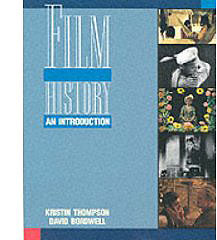 We were part of this generation of revisionists. In the 1970s and 1980s Kristin concentrated on European and American silent film, studying both stylistic movements and film distribution, as well as particular filmmakers like Eisenstein, Godard, and Tati. I did work on European and Japanese cinema. We spent years working on a reconsideration of the history of American studio film in collaboration with Janet Staiger. Writing The Classical Hollywood Cinema: Film Style and Mode of Production to 1960 we realized that asking fresh questions was both necessary and exciting.
We were part of this generation of revisionists. In the 1970s and 1980s Kristin concentrated on European and American silent film, studying both stylistic movements and film distribution, as well as particular filmmakers like Eisenstein, Godard, and Tati. I did work on European and Japanese cinema. We spent years working on a reconsideration of the history of American studio film in collaboration with Janet Staiger. Writing The Classical Hollywood Cinema: Film Style and Mode of Production to 1960 we realized that asking fresh questions was both necessary and exciting.
That’s what made our task perilous. Everything, it seemed, needed to be rethought.
Most obviously, countries outside Europe and North America had been neglected. One of my favorite film statistics is this, to quote from our book:
In the mid-1950s, the world was producing about 2800 feature films per year. About 35 percent of these came from the United States and western Europe. Another 5 percent were made in the USSR and the Eastern European countries under its control. . . . Sixty percent of feature films were made outside the western world and the Soviet bloc. Japan accounted for about 20 percent of the world total. The rest came from India, Hong Kong, Mexico, and other less industrialized nations. Such a stunning growth in film production in the developing countries is one of the major events in film history.
Traditional histories, and film history textbooks, had virtually ignored the bulk of film-producing nations. Only one or two major directors would step in from the shadows. Kurosawa summed up Japan, Satayajit Ray stood in for India. And the books’ layout of chapters indicated this second-class status. The history of film was Euro-American, with East Asia, Southeast Asia, South America, and Africa, appearing, if at all, in periods when westerners first got glimpses of their film culture. So Japan was typically first mentioned after World War II, when Rashomon won a prize at the Venice Film Festival. One would hardly know that there were many, and many great, Japanese filmmakers working in a long-standing tradition.
As if this weren’t enough, we were determined to include other varieties of artistic filmmaking. Documentary cinema, animation, and experimental film had attracted subtle historians like Bill Nichols, Mike Barrier, and P. Adams Sitney. We weren’t experts in these areas, but we were keenly interested in the debates in that domain, and so, guided by these and other scholars, we sought to integrate the histories of documentary, avant-garde, and animated cinema into our survey.
Kristin and David’s excellent adventure
Straight Shooting (1917).
In sum, we decided that we could write a plausible international history of cinema—not a be-all and end-all, but a new draft that reflected the rich variety of new findings and fresh perspectives. Like all historians, we had to be selective. We couldn’t, for instance, track every nuance of the “false starts and detours” in early film technique. More globally, we decided to concentrate on three lines of inquiry.
First, we studied changes in modes of film production and distribution. This inquiry committed us to a version of industrial history. How filmmaking was embedded in particular times and places, how it connected to local culture and national politics: these factors affected the ways films were made and circulated. For example, the early distribution of films followed the trade routes of late nineteenth-century imperialism. That global system started to crack with the start of World War I. A new world power, the United States, became the major film exporting country—a position it has enjoyed for most years since then.
Secondly, we studied changes in film form, style, and genre. We treated these artistic matters as not wholly the products of individual innovators but also as more widely-developed practices and norms. This emphasis on norms allowed us to link, in some degree, the development of technique to opportunities and constraints presented by film industries.
This angle of approach also meant looking at older works with a fresh eye, informed by others’ research but also by our own interests in film as an art. We were obliged to seek out films lying outside the orthodox story. Birth and Caligari and M feature in our account, but so do The Cheat and Assunta Spina and Liebelei. In those pre-DVD days, few of the titles we sought could be found on video, but we preferred to watch film on film anyway. So it was off to the archives. Fortunately, many collections were wide-ranging. We saw Egyptian and Swedish films in Rochester, French and Italian films in London, Indian and Japanese films in Washington, D. C., Polish and African films in Brussels. Committed to documenting our claims with frame enlargements, not production stills, we were lucky to be able to take photos from many of the movies we saw.
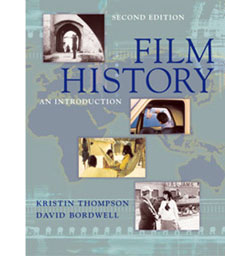 In looking at national film industries and artistic change, we wanted to go beyond local observations. So a third question pressed upon us. What international trends emerged that knit together developments in different countries? We could not claim expertise in all the relevant national traditions, but we could, by drawing on films and other scholars’ writings, create a comparative study that gave a sense of the broad shape of film history.
In looking at national film industries and artistic change, we wanted to go beyond local observations. So a third question pressed upon us. What international trends emerged that knit together developments in different countries? We could not claim expertise in all the relevant national traditions, but we could, by drawing on films and other scholars’ writings, create a comparative study that gave a sense of the broad shape of film history.
For example, we could point to the emergence of tableau cinema in many countries in the 1910s. We could consider various models of state-controlled cinema in the 1930s and discover the “New Waves” that emerged not only in France but around the world in the late 1950s and early 1960s. Citizen Kane popularized a “deep-focus” look, but comparative study showed us that its principles were prefigured in Soviet cinema of the 1930s and spread to most major filmmaking nations in the 1940s. Not all trends march in lockstep, but there was enough synchronization to let us plot broad waves of change across the 100 years of film. Our aim was a truly comparative film history.
As a kind of overarching commitment, we wanted readers to think about what historical processes had shaped earlier historical frames of reference. How, for instance, did the “standard story” and the mainline canon get established in the first place? Part of the answer lies in the growth of film journalism and film archives. Why did Fellini, Bergman, Kurosawa, and other directors get so much fame in the 1950s and 1960s? True, they made exceptional films, but so did many other directors who remained unknown to a wider public. We suggested that the “golden age of auteurs” owed a good deal to developments in film criticism and to the postwar growth of film festivals. What led Japanese anime to a period of international popularity in the 1980s? Not only worldwide television distribution, but also devoted fans who spread their gospel through fanzines, videocassettes, and the youthful Internet. The “institutional turn” in film research of the 1970s and 1980s pushed us to consider how film industries and international film culture governed the way films were made and circulated.
The research programs that were launched in the 1970s were characterized by a greater self-consciousness than we had seen before. Historians questioned their assumptions and explanations. Why attribute originality only to “great men” without also examining their circumstances? Why presuppose that film technique grows and progresses in a linear way? To capture this new self-consciousness about purposes and methods, we incorporated something that had never been seen in a film history before: an introduction to historiography. In its latest incarnation it can be found elsewhere on this site. We also appended to each chapter short “Notes and Queries” discussing intriguing side issues, debates in the field, and topics for further research.
Up-to-date, and beyond
10 Canoes (2006).
The result of our efforts was first published by McGraw-Hill in 1994 as Film History: An Introduction. A second edition appeared in late 2002. More recently, we’ve spent about twenty months preparing a third edition, which will be published on 20 February this year.
We thought that writing the first edition was bloody hard, and it didn’t get any easier on the second or third pass. As usual, however, visiting new material broadens your compass. Writing my portions of the first edition had a profound impact on my research, but also on my personal tastes. The activity awakened my interest in Hindi cinema of the 1950s, Latin American cinema of the 1960s, experimental work of the 1980s, and African film of the 1990s. On this third round, I was caught up in the innovations of contemporary Korean film and of avant-gardists like Sharon Lockhart. Overall, our urge to trace cinematic creativity around the world led us to a greater appreciation of the wonders of film.
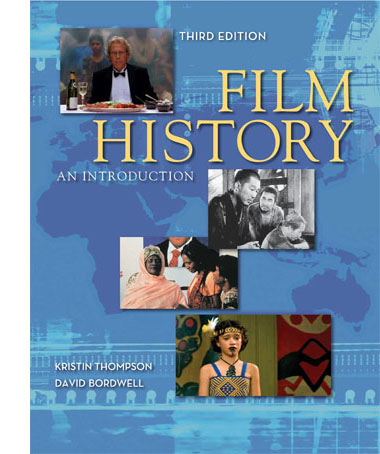 Film History‘s third edition consists of six parts. The first looks at early cinema, from the 1880s to the end of the 1910s. The second considers the late silent era through the 1920s and slightly beyond. Part Three surveys the international development of sound film, up to 1945. The postwar era, from 1945 to the end of the 1960s, constitutes Part Four. We next consider the contemporary period, generously conceived as running from the 1970s to the present. The last section, Cinema in the Age of Electronic Media, makes up for the broad compass of Part Five by reconsidering trends that took shape during the 1980s.
Film History‘s third edition consists of six parts. The first looks at early cinema, from the 1880s to the end of the 1910s. The second considers the late silent era through the 1920s and slightly beyond. Part Three surveys the international development of sound film, up to 1945. The postwar era, from 1945 to the end of the 1960s, constitutes Part Four. We next consider the contemporary period, generously conceived as running from the 1970s to the present. The last section, Cinema in the Age of Electronic Media, makes up for the broad compass of Part Five by reconsidering trends that took shape during the 1980s.
What’s new in this edition? Several small changes have been made in the early portions to reflect newly available films and filmmakers now recognized as important. We have updated coverage of documentary with discussions of the rise of the theatrical doc and its two most striking practitioners, Errol Morris and Michael Moore. We have likewise expanded our section on avant-garde filmmaking by considering “paracinema,” which should have been in earlier editions, and the increase in cinema presented as installations and gallery works.
As for national cinema developments, we have extended our survey of western Europe and the USSR (Chapter 25), continental and subcontinental cinemas such as Latin America, Africa, and India (Chapter 26), and East Asia and Oceania (Chapter 27). New coverage is given to the recovery of the Russian and Chinese industries, the increasing world presence of Bollywood, and fresh talent from the Middle East and South Korea.
The book’s last part continues to host a chapter (28) on American cinema’s development in the light of home video and the rise of independent filmmaking; the blockbuster and Mumblecore are among the subjects we tackle. As in the second edition, we devote a chapter to globalization, which lets us trace the struggle between Hollywood’s global blockbusters and countervailing trends in other regions. This chapter allows us to study other globalizing processes, such as multiplexing, the Internet, fan culture, piracy, and diasporic populations.
Chapter 30 is new to this edition. It examines the effects of the digital revolution on all aspects of film production, as well as on new means of distribution and exhibition. The subjects covered include 3-D animation, DIY independents, and online distribution. We end by recognizing film as no less international an art form than it was in the earliest decades, when silent films slipped freely across national borders.
As in the early editions, we’ve tried to synthesize contemporary contributions but also add our own research and our own interpretations. Here, for example, is our very cine-centric conclusion about “the death of film.”
Will this barrage of new media ultimately overwhelm the cinema? Will the Internet, video games, and personal music players take over as the preferred forms of entertainment? Possibly, but there is evidence against that notion.
Each time that a digital platform appeared, it initially lacked the capacity to show films. Yet each platform adapted itself in order to add that capacity. In the 1990s, computers acquired the power to display movies. The Internet originally did not show films, but now it has Quicktime and downloads. Cell phones started out as communication devices, but later models included a camera and screen so that users could shoot and view films. The first game consoles could not show movies, but after the advent of DVDs, the next generation of machines became combination players. The original iPod and other personal music devices were strictly for audio, but Apple added the capacity to download digital video from computers, DVDs, and the Internet. The iPod enlarged its screen to better display films, even though that meant abandoning the signature click-wheel in favor of touch-screen controls.
Far from killing movies, digital media have allowed them to leave the theater and our living rooms. Now they can travel with us almost anywhere. In effect, film has reshaped the new media to accommodate it. As new digital devices emerge, we suspect that they, too, will adjust themselves to the cinematic traditions that have developed over 110 years.
No book can be definitive, partly because things change astonishingly fast. When we wrote the revision, DreamWorks was firmly within the Paramount family, and our chart of media conglomerates on p. 683 left it there. In page proofs, we shifted it when it seemed all but certain to move to Universal. Now comes the news that DreamWorks has signed with Disney. Likewise, the flow of important research hasn’t abated, and valuable books, like Jay Beck and Tony Grajeda’s Lowering the Boom: Critical Studies in Film Sound, were published after we went to press. Another peril of writing contemporary history, then: Keeping up.
To squeeze in our new material, we’ve had to excise the historiography essay mentioned above, as well as our Notes and Queries and our plump bibliographies. Those, all updated, have appeared at the McGraw-Hill site. Even if you’re not reading the book, feel free to go to the Student Edition tab and browse through the Notes and Queries for each chapter. Some of these brief, bloggish items may pique your interest.
Without exactly planning to do it, we seem to have come up with the most wide-ranging, extensively illustrated survey of world cinema history available in English. The third edition of Film History: An Introduction runs to 750 large-format pages, not counting the index. It contains hundreds of black-and-white frame enlargements and thirty pages of color illustrations.
We hope that if you’re interested in film history you’ll take a look. Feel free to write to us with your thoughts, especially if you find misprints (we’ve been chasing them for months) and factual errors. We’d also appreciate comments about our larger arguments and interpretations. We improve only by constantly rechecking what we say and how we say it.
The quotation about 1950s world film output comes from Kristin Thompson and David Bordwell, Film History: An Introduction, third ed. (New York: McGraw-Hill, 2009), 373.
Tokyo Drifter (1966).
Grandmaster flashback
DB here:
Elsewhere I’ve sung the glories of Turner Classic Movies. Would that the other basic-cable staple, the Fox Movie Channel, were as committed to classic cinema. It’s curious that a studio with a magnificent DVD publishing program (the Ford boxed set, the Murnau/ Borzage one) is so lackluster in its broadcast offerings. Fox was one of the greatest and most distinctive studios, and its vaults harbor many treasures, including glossy program pictures that would still be of interest to historians and fans. Where, for instance, is Caravan (1934), by the émigré director Erik Charell who made The Congress Dances (1931)? Caravan‘s elaborate long takes would be eye candy for Ophuls-besotted cinephiles.
Occasionally, though, the Fox schedulers bring out an unexpected treat, such as the sci-fi musical comedy Just Imagine (1930). Last month, the main attraction for me was The Power and the Glory (1933), directed by William K. Howard from a script by Preston Sturges.
This was an elusive rarity in my salad days. As a teenager I read that it prefigured Citizen Kane, presenting the life of a tycoon in a series of daring flashbacks. I think I first saw it in the late 1960s at a William K. Everson screening at the New School for Social Research. I caught up with it again in 1979, at the Thalia in New York City, on a double bill with The Great McGinty (1940). In my files, along with my scrawls on ring-binder paper, is James Harvey’s brisk program note, which includes lines like this: “One of Sturges’ achievements was to make movies about ordinary people that never ever make us think of the word ‘ordinary.’” I was finally able to look closely at The Power and the Glory while doing research for The Classical Hollywood Cinema (1985). The UCLA archive kindly let me see a 16mm print on a flatbed viewer.
So after a lapse of twenty-eight years I revisited P & G on the Fox channel last month. It does indeed prefigure Kane, but I now realize that for all its innovations it belongs to a rich tradition of flashback movies, and it can be correlated with a shorter-term cycle of them. Rewatching it also teased me to think about flashbacks in general, and to research them a little. You see, I am very fond of what contemporary practitioners like to call broken timelines.
A trick, an old story
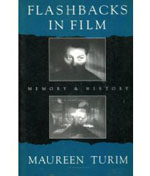 On our subject for today, the indispensible book, which ought to be brought back into print or archived online, is Maureen Turim’s Flashbacks in Film: Memory and History (Routledge, 1989). We may think of the flashback as a modern technique, but Turim shows that flashbacks have been a mainstay of filmic storytelling since the 1910s.
On our subject for today, the indispensible book, which ought to be brought back into print or archived online, is Maureen Turim’s Flashbacks in Film: Memory and History (Routledge, 1989). We may think of the flashback as a modern technique, but Turim shows that flashbacks have been a mainstay of filmic storytelling since the 1910s.
Although the term flashback can be found as early as 1916, for some years it had multiple meanings. Some 1920s writers used it to refer to any interruption of one strand of action by another. At a horse race, after a shot of the horses, the film might “flash back” to the crowd watching. (See “Jargon of the Studio,” New York Times for 21 October 1923, X5.) In this sense, the term took on the same meaning as then-current terms like “cut-back” and “switch-back.” There was also the connotation of speed, as “flash” was commonly used to denote any short shot.
But around 1920 we also find the term being used in our modern sense. You can find it in popular fiction; one short story has its female protagonist remembering something “in a confused flashback.” F. Scott Fitzgerald writes in The Beautiful and Damned of 1922:
Anthony had a start of memory, so vivid that before his closed eyes there formed a picture, distinct as a flashback on a screen.
At about the same time writers on theatre start to adopt the term and credit it to film. A historian of drama writes in 1921 of a play that rearranges story order:
The movies had not yet invented the flashback, whereby a thing past may be repeated as a story or a dream in the present.
Within film circles, there were signs of an exasperation with the device. One 1921 writer calls the flashback a “murderous assault on the imagination.” Turim quotes a New York Times review of His Children’s Children (1923):
For once a flash-back, as it is made in this photoplay, is interesting. It was put on to show how the older Kayne came to say his prayers.
In the same year, a critic discusses Elmer Rice’s On Trial, an influential 1911 stage play. Rice employs
a dramatic technique which up to its time was probably unique, though since then the ever recurrent “flash back” of the movies has made the trick an old story.
During the 1930s, although some critics and filmmakers employed older terms like “switch back” and “retrospect,” flashback seems to have become the standard label. It denoted any shot or scene that breaks into present-time action to show us something that happened in the past. It probably speaks to the intuitive and informal nature of filmmaking that writers and directors didn’t feel a need to name a technique that they were using confidently for two decades.
The early flashback films pretty much set the pattern for what would come later. Turim shows that all the sorts we find today have their precedents in the 1910s and 1920s. Adapting her typology a little bit, we can distinguish between character-based flashbacks and “external” ones.
A character-based flashback may be presented as purely subjective, a person’s private memory, as in Letter to Three Wives or The Pawnbroker or Across the Universe. There’s also the flashback that represents one character’s recounting of past events to another character, a sort of visual illustration of what is told. This flashback is often based on testimony in a trial or investigation (Mortal Thoughts, The Usual Suspects), but it may simply involve a conversation, as in Leave Her to Heaven, Titanic, or Slumdog Millionaire. It can also be triggered by a letter or diary, as happens with the doubly-embedded journals in The Prestige.
An alternative is to break with character altogether and present a purely objective or “external” flashback. Here an impersonal narrating authority simply takes us back in time, without justifying the new scene as character memory or as illustration of dialogue. The external flashback is uncommon in classic studio cinema (although see A Man to Remember, 1938) but was common in the 1900s and 1910s and has returned in contemporary cinema. Typically the film begins at a point of crisis before a title appears signaling the shift to an earlier period. Recent examples are Michael Clayton (“Three days earlier”), Iron Man (“36 Hours Before”), and Vantage Point (“23 Minutes Earlier”).
In current movies, flashbacks can fall between these two possibilities. Are the flashbacks in The Good Shepherd the hero’s recollections (cued by him staring blankly into space) or more objective and external, simply juxtaposing his numb, colorless life with the past disintegration of his family? The point would be relevant if we are trying to assess how much self-knowledge he gains across the present-time action of the film.
Rationales for the flashback
What purposes does a flashback fulfill? Why would any storyteller want to arrange events out of chronological order? Structurally, the answers come down to our old friends causality and parallelism.
Most obviously, a flashback can explain why one character acts as she or he does. Classic instances would be Hitchcock’s trauma films like Spellbound and Marnie. A flashback can also provide information about events that were suppressed or obscured; this is the usual function of the climactic flashback in a detective story, filling in the gaps in our knowledge of a crime.
By juxtaposing two incidents or characters, flashbacks can enhance parallels as well. The flashbacks in The Godfather Part II are positioned to highlight the contrasts between Michael Corleone’s plotting and his father’s rise to power in the community. Citizen Kane’s flashbacks are famous for juxtaposing events in the hero’s life to bring out ironies or dramatic contrasts.
Of course, flashbacks need not explain or clarify things; they can make things more complicated too. We tend to think of the “lying flashback” as a modern invention (a certain Hitchcock film has become the prototype), but Turim shows that The Goose Woman (1925) and Footloose Widows (1926) did the same thing, although not with the same surprise effect. Kristin points out to me that an even earlier example is The Confession (1920), in which a witness at a trial supplies two different versions of a killing we have already (sort of) seen.
At the limit, flashbacks can block our ability to understand characters and plot actions. This is perhaps best illustrated by Last Year at Marienbad, but the dynamic is already there in Jean Epstein’s La Glace à trois faces (“The Three-Sided Mirror,” 1927).
I argue in Poetics of Cinema that, at bottom, flashbacks are tactics fulfilling a broader strategy: breaking up the story’s chronological order. You can begin the film at a climactic moment; once the viewers are hooked, they will wait for you to move back to set things up. You can create mystery about an event that the plot has skipped over, then answer the question through a flashback. You can establish parallels between past and present that might not emerge so clearly if the events were presented in 1-2-3 order. Consequently, you can justify the switch in time by setting up characters as recalling the past, or as recounting it to others.
Having a character remember or recount the past might seem to make the flashback more “realistic,” but flashbacks usually violate plausibility. Even “subjective” flashbacks usually present objective (and reliable) information. More oddly, both memory-flashbacks and telling-flashbacks usually show things that the character didn’t, and couldn’t, witness.
I don’t suggest that recollections and recountings are merely alibis for time-juggling. They bring other appeals into the storytelling mix, such as allegiance with characters, pretexts for point-of-view experimentation, and so on. Still, the basic purpose of nonchronological plotting, I think, is to pattern information across the film’s unfolding so as to shape our state of knowledge and our emotional response in particular ways. Scene by scene and moment by moment, flashbacks play a role in pricking our curiosity about what came before, promoting suspense about what will happen next, and enhancing surprise at any moment.
A trend becomes a tradition
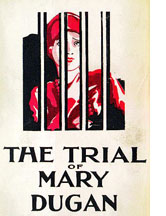 When The Power and the Glory was released in August 1933, it was part of a cycle of flashback films. The Trial of Mary Dugan (1929), The Trial of Vivienne Ware (1932), and other courtroom films rendered testimony in flashbacks. A film might also wedge a brief or extended flashback into an ongoing plot. The most influential instance was probably Smilin’ Through (1931), which is notable for using a crane shot through a garden to link present and past.
When The Power and the Glory was released in August 1933, it was part of a cycle of flashback films. The Trial of Mary Dugan (1929), The Trial of Vivienne Ware (1932), and other courtroom films rendered testimony in flashbacks. A film might also wedge a brief or extended flashback into an ongoing plot. The most influential instance was probably Smilin’ Through (1931), which is notable for using a crane shot through a garden to link present and past.
Also well-established was the extended insert model. Here we start with a critical situation that triggers a flashback (either subjective or external), and this occupies most of the movie. Digging around, I found these instances, but I haven’t seen all of them; some don’t apparently survive.
- Behind the Door (1919): An old sea salt recalls life in World War I and, back in the present, punishes the man responsible for his wife’s death. A ripoff of Victor Sjöström’s Terje Vigen (1917)?
- An Old Sweetheart of Mine (1923): A husband goes through a trunk in an attic and finds a memento that reminds him of childhood sweetheart. The pair grow up and marry, facing tribulations. At the end, back in the present, she comes to the attic with their kids.
- His Master’s Voice (1925): Rex the dog is welcomed home from the war. An extended flashback shows his heroic service for the cause, and back in the present he is rewarded with a parade.
- Silence (1926): A condemned man explains the events that led up to the crime. Back in the present, on his way to be executed, he is saved.
- Forever After (1926): On a World War I battlefield, a soldier recalls what brought him there.
- The Woman on Trial (1927): A defendant recalls her past.
- The Last Command (1928): One of the most famous flashback films of the period. An old movie extra recalls his life in service of the tsar.
- Mammy (1930): A bum reflects on the circumstances leading him to a life on the road.
- Such is Life (1931): A ghoulish item. A fiendish scientist confronts a young man with the corpse of the woman he loves. A flashback to their romance ensues.
- The Sin of Madelon Claudet (1931; often cablecast on TCM): A young wife bored with her husband is told the story of a neighbor woman who couldn’t settle down.
- Two Seconds (1932): A man about to be executed remembers, in the two seconds before death, what led him here. A more mainstream reworking of a premise of Paul Fejos’s experimental Last Moment (1928), which is evidently lost.
An interesting variant of this format is Beyond Victory, a 1931 RKO release. The plot presents four soldiers on the battlefield, each one recalling his courtship of the woman he loves back home. The principle of assembling flashbacks from several characters was at this point prised free of the courtroom setting, and multiple-viewpoint flashbacks became important for investigation plots like Affairs of a Gentleman (1934), Through Different Eyes (1942), The Grand Central Murder (1942), and of course Citizen Kane, itself a sort of mystery tale.
Why this burst of flashback movies? It’s a good question for research. One place to look would be literary culture. The technique of flashback goes back to Homer, and it recurs throughout the history of both oral and written narrative. Literary modernism, however, made writers highly conscious of the possibility of scrambling the order of events. From middlebrow items like The Bridge of San Luis Rey (1927) to high-cultural works by Dos Passos and Faulkner, elaborate flashbacks became organizing principles for entire novels. It’s likely that Sturges, a Manhattanite of wide literary culture, was keenly aware of this trend.
It’s just as likely that he noticed similar developments in another medium. By 1931, when Katharine Seymour and J. T. W. Martin published How to Write for Radio (New York: Longmans, Green), they could devote considerable discussion to frame stories and flashbacks in radio drama (pp. 115-137). Especially interesting for Sturges’ film, radio programs were letting the voice of the announcer or the storyteller drift in and out of the action that was taking place in the past.
For whatever reasons, the technique became more common. The year 1933 saw several flashback films besides The Power and the Glory. In the didactic exploitation item Suspicious Mothers, a woman recounts her wayward path to redemption. Mr. Broadway offers an extensive embedded story using footage from another film (a common practice in the earliest days). Terror Aboard begins with the discovery of corpses on a foundering yacht, followed by an extensive flashback tracing what led up the calamity. A borderline case is the what-if movie Turn Back the Clock (1933). Ever-annoying Lee Tracy plays a small businessman run down by a car. Under anesthesia, he reimagines his life as it might have been had he married the girl he once courted. Call it a rough draft for the “hypothetical flashbacks” that Resnais was to exploit in his great La Guerre est finie.
The point of this cascade of titles is that in writing The Power and the Glory, Sturges was working with a set of conventions already in wide circulation. His inventiveness stands out in two respects: the handling of voice-over and the ordering of the flashbacks.
Now I’m about to divulge details of The Power and the Glory.
Narratage, anyone?
The film begins with what became a commonplace opening gesture of film, fiction, and nonfiction biography: the death of the protagonist. We are at the funeral of Thomas Garner, railroad tycoon. His best friend and assistant Henry slips out of the service. After visiting the company office, Henry returns home. Sitting in the parlor with him, his wife castigates Garner as a wicked man. “It’s a good thing he killed himself.” So we have the classic setup of retrospective suspense: We know the outcome but become curious about what led up to it.
Henry’s defense of Garner launches a series of flashbacks. As a boyhood friend, Henry can take us to three stages of the great man’s life: adolescence, young manhood, and late middle age. Scenes from these time periods are linked by returns to the narrating situation, when Henry’s wife will break in with further criticisms of Garner.
Sturges boasted in a letter to his father: “I have invented an entirely new method of telling stories,” explaining that it combines silent film, sound film, and “the storytelling economy and the richness of characterization of a novel.” At the time, the Paramount publicists trumpeted that the film employed a new storytelling technique labeled narratage, a wedding of “narrating” and “montage.” One publicity item called it “the greatest advance in film entertainment since talking pictures were introduced.” Hyperbole aside, what did Sturges have in mind?
There is evidence that some screenwriters were rethinking their craft after the arrival of sound filming. Exhibit A is Tamar Lane’s book, The New Technique of Screen Writing (McGraw-Hill, 1936). Lane suggests that the talking picture’s promise will be fulfilled best by a “composite” construction blending various media. From the stage comes dialogue technique and sharp compression of action building to a strong climax. From the novel comes a sense of spaciousness, the proliferation of characters, a wider time frame, and multiple lines of action. Cinema contributes its own unique qualities as well, such as the control of tempo and a “pictorial charm” (p. 28) unattainable on the stage or page.
Vague as Lane’s proposal is, it suggests a way to think about the development of Hollywood screenwriting at the time. Many critics and theorists believed that the solution to the problem of talkies was to minimize speech; this is still a common conception of how creative directors dealt with sound. But Lane acknowledged that most films would probably rely on dialogue. The task was to find engaging ways to present it. Several films had already explored some possibilities, the most notorious probably being Strange Interlude (1932). In this MGM prestige product, the soliloquys spoken by characters in O’Neill’s play are rendered as subjective voice-over. The result, unfortunately, creates a broken tempo and overstressed acting. A conversation will halt, and through changes of facial expression the performer signals that what we’re now hearing is purely mental.
The Power and the Glory responds to the challenge of making talk interesting in a more innovative way. For one thing, there is the sheer pervasiveness of the voice-over narration. We’re so used to seeing films in which the voice-over commentary weaves in and out of a scene’s dialogue that we forget that this was once a rarity. Most flashback films in the early sound era had used the voice-over to lead into a past scene, but in The Power and the Glory, Henry describes what we see as we see it.
Most daringly, in one scene Henry’s voice-over substitutes for the dialogue entirely. Young Tom and Sally are striding up a mountainside, and he’s summoning up the nerve to propose marriage. What we hear, however, is Henry at once commenting on the action and speaking the lines spoken by the couple, whose voices are never heard.
This scene, often commented upon by critics then and now, seems have exemplified what Sturges late in life recalled “narratage” to be. Describing that technique in his autobiography, he wrote: “The narrator’s, or author’s, voice spoke the dialogue while the actors only moved their lips” (p. 272).
So one of Sturges’ innovations was to use the voice-over not only to link scenes but to comment on the action as it played out. In her pioneering book Invisible Storytellers: Voice-Over Narration in American Fiction Film (Univesity of California Press, 1988), Sarah Kozloff has argued that the pervasiveness of Henry’s narration has no real precedent in Hollywood, and few successors until 1939 (pp. 31-33). (There’s one successor in Sacha Guitry’s Roman d’un tricheur.) The novelty of the device may have led Sturges and Howard toward redundancies that we find a little labored today. The transitions into the past from the frame story are given rather emphatically, with Henry’s voice-over aided by camera movements that drift away from the couple. (Compare the crisp shifts in Midnight Mary, below.) Henry’s comments during the action are sometimes accentuated by diagonal veils that drift briefly over the shot, as if assuring us that this speech isn’t coming from the scene we see.
The “montage” bit of “narratage” also invokes the idea of a series of sequences guided by the voice-over narrator. The concept might also have encompassed the most famous innovation of The Power and the Glory: Sturges’ decision to make Henry’s flashbacks non-chronological.
Even today, most flashback films adhere to 1-2-3 order in presenting their embedded, past-tense action. But Sturges noticed that in real life people often recount events out of order, backing and filling or free-associating. So he organized The Power and the Glory as a series of blocks. Each block contains several scenes from either boyhood, youth, or middle age. Within each block, the scenes proceed chronologically, but the narration skips around among the blocks.
For example, a block of boyhood scenes gives way to a set showing Garner, now in middle age, ordering around his board of directors. The next cluster of flashbacks returns to Garner’s youth and his courtship of his first wife, Sally. Then we are carried back to his middle age, with scenes showing Garner alienated from Sally and his son Tommy but also attracted to the young woman Eve. And from there we return to Garner’s early married life with Eve.
To keep things straight, Sturges respects chronology along another dimension. Not only do the scenes within each block follow normal order, but the plotlines developing across the three phases of Garner’s life are given 1-2-3 treatment. In one block of flashbacks, we see Tom and Sally courting. When we return to that stage of their lives in another block, they are happily married. The next time we see Garner as a young man, he is improving himself by attending college. The later romance with Eve develops in a similar step-by-step fashion across the blocks devoted to middle age.
A major effect of the shuffling of periods is ironic contrast. Maureen Turim points out that seeing different phases of Garner’s life side by side points up changes and disparities. In his youth, Tom watches the birth of his son with awe; in the next scene, we are reminded what a wastrel young Tommy turned out to be.
The juxtaposition of time frames also nuances character development. As Sally ages, she turns into something of a nag, quarreling with her husband and pampering Tommy. But in the next sequence we see her young, ambitiously pushing Tom to succeed and willing to undergo sacrifice by taking up his job as a railroad track-walker. The next scenes show Tom in class and in a bar while Sally walks the desolate tracks in a blizzard. She has given up a lot for her husband. In the next scene, set in middle age, Garner confesses his love to Eve but says he could never leave Sally, and the juxtaposition with Sally’s solitary track-walking suggests that he recognizes her sacrifice. And in the following scene, when Sally comes to Garner’s office, she admits that she has become disagreeable and asks if they couldn’t take a trip to reignite their love. The juxtaposition of scenes has turned a caricatural shrew into a woman who is a more complex mixture of devotion, disenchantment, and self-awareness.
Other characters aren’t given this degree of shading—Tommy is pretty much a wastrel, Eve a vamp—but another married couple deepens the central parallel. Meek Henry is dominated by his wife, but by the end she is chastened by what she learns of Garner’s real motives. Critic Andy Horton, in his helpful introduction to Sturges’ published screenplay, indicates that this couple adds a note of contentment to what is otherwise a pretty sordid melodrama of adultery and quasi-incest.
The innovative flashbacks and voice-overs are an important part of the film’s appeal, but director William K. Howard supplied some craftsmanship of his own. Particularly striking are some silhouette effects, low angles, and deep-focus compositions that underscore the parallels between Sally’s suicide and Garner’s impending death.
The original screenplay suggests that Sturges intended to push his innovations further. About halfway through, he starts to break down the time-blocks. In the script, Sally visits Garner while he’s working on a bridge. The next scene shows their son Tommy already grown and spoiled, being taken back into his father’s good graces. Then the script returns to the bridge, where Sally tells Tom she’s pregnant. The interruption of the bridge scene reminds us of how badly their child turned out.
The script jumps back to the birth of the baby. In the film the birth scene plays out in its entirety, but in the screenplay Sturges cuts it off by the scene (retained in the film) showing Garner’s marriage to Eve. The final moments of the birth scene, when Garner prays (“Thou art the power and the glory”), become in the script the very end of the film. Coming after Tom’s death at the hand of his son, this epilogue is a bitter pill, rendered all the harder to take by providing no return to Henry and his wife.
The greater fragmentation of the second part of the script, along with Garner’s death as a sort of murder-suicide and the failure to return to the narrating frame, is striking. It’s as if Sturges felt he could take more chances, counting on his viewers’ familiarity with current flashback conventions and on his film’s firmly established time-shuttling method. But if, as sources report, Sturges’ script was initially filmed exactly as written, then it seems likely that the film’s June 1933 preview provoked the changes we find in the finished product. “The first half of the picture,” he remarked in a letter, “went magnificently, but the storytelling method was a little too wild for the average audience to grasp and the latter half of the picture went wrong in several spots. We have been busy correcting this and the arguments and conferences have been endless.”
Even the compromised film proved difficult for audiences. Tamar Lane, proponent of the “composite” form suitable for the sound cinema, felt that the “retrospects” in The Power and the Glory were too numerous and protracted. Nonetheless, he praised it for its “radical and original cinema handling” (p.34). That handling rested upon tradition—a tradition that in turn encouraged innovations. Once flashbacks had become solid conventions, Sturges could risk pushing them in fresh directions.
Mary remembers
Finally, two more flashy flashback movies from 1933. Some spoilers.
Midnight Mary (MGM, William Wellman) works a twist on the courtroom template. The defendant Mary Martin is introduced jauntily reading a magazine while the prosecutor demands that the jury find her guilty of murder. This also sets up a nice little motif of shots highlighting Loretta Young’s lustrous eyes. The motif pays off with a soft-focus shot of her in jail just before the climax.
As the opening scene ends, Mary is led to a clerk’s office to wait for the verdict. There’s an automatic dose of suspense (Will she be found guilty?) but there’s also considerable curiosity: Whom has she killed? How was she caught?
These questions won’t be answered for some time. Lounging in the clerk’s office, Mary runs her eye runs across the annual reports filling his shelves. The flashbacks, which comprise most of the film, are introduced as close-ups of the volumes’ spines—1919, 1923, 1926, 1927, and so on up to the present. They serve as neatly motivated equivalents of those clichéd calendar pages that ripple through montage sequences of the 1930s.
The flashbacks are motivated as subjective; Mary doesn’t recount her life to the clerk but simply reviews it in her mind. Unlike the flashbacks in The Power and the Glory, they are chronological and without gaps. Nothing is skipped over to be revealed later. As usual, though, once Mary’s recollections have triggered the rearrangement of story order, the flashbacks are filmed as any ordinary scenes would be, including bits of action that she isn’t present to witness. The film is a good example of using the extended-flashback convention chiefly to delay the resolution of the climactic action. Told in chronological order, Mary’s tale of woe would have had much less suspense.
Transitions between present and past are areas open to innovation, and early sound filmmakers took advantage of them. In Midnight Mary, the long flashback closes with gangsters pounding on the door of Mary’s boudoir; this sound continues across the dissolve to the present, with Mary roused from her reverie by a knock on the clerk’s office door. Earlier, one transition into the past begins with Mary blowing cigarette smoke toward the bound volumes on the shelf.
Dissolve to a close-up of one book as smoke wafts over it, and then to a shot of Mary’s gangster boyfriend blowing cigarette smoke out before he sets up a robbery..
At one point the narration supplies a surprise by abruptly shifting into the present. Once Mary has become a prostitute, she is slumped over a barroom table in sorrow, while her pal Bunny consoles her. In a tight shot, Bunny (Una Merkel, always welcome), leans over and says: “Oh, what’s the diff, Mary? A girl’s gotta live, ain’t she?”
Cut directly to the present, with Mary murmuring: “Not necessarily, Bunny. The jury’s still out on that.”
Mary’s reply casts Bunny’s question about needing to live in a new light, since Mary is facing execution, and the use of the stereotyped phrase, “The jury’s still out,” now with a double meaning, reminds us of the present-tense crisis. It is a more crisp and concise link than the transitions we get in The Power and the Glory. But then, Wellman has no need for continuous voice-over, which gives the Sturges/ Howard film its more measured pace.
Filmmakers were concerned with finding storytelling techniques appropriate to the sound film, and these unpredictable links between sequences became characteristic of the new medium. Similar links had appeared in silent films, but they gained smoothness and extra dimensions of meaning when the images were blended with dialogue or music. For more on transitional hooks, go here.
Nora and narratage
The hooks between scenes are perhaps the least outrageous stretches of The Sin of Nora Moran, a Majestic release that, thanks to a gorgeous restoration and a DVD release, has rightly earned a reputation as the nuttiest B-film of the 1930s.
It is a flashback frenzy, boxes within boxes. A District Attorney tells the governor’s wife to burn the apparently incriminating love letters she’s found. In explaining why, the D. A. introduces a flashback (or is it a cutaway?) to Nora in prison. We then move into Nora’s mind and see her hard life, the low point occurring when she’s raped by a lion tamer.
Now we start shuttling between the D. A. telling us about Nora and Nora remembering, or dreaming up, traumatic events. At some points, characters in her flashbacks tell her that what she’s experiencing is not real. In one hazy sequence, her circus pal Sadie materializes in her cell to remind Nora that she killed a man. (Actually, she didn’t.) At other moments Nora’s flashbacks include moments in which she says that if she does something differently, it will change—it being the outcome of the story. At this point another character will point out that they can’t change the outcome because it has already happened . . . of course, since this is a flashback.
By the end, after the governor has had his own flashback to the end of his affair with Nora and after she appears as a floating head, things have gotten out of hand. The rules, if there are any, keep changing. And the whole farrago is propelled by furious montage sequences built out of footage scavenged from other films.
Publicity and critical response around The Sin of Nora Moran implied that the movie followed the “narratage” method. There was surely some influence. Scenes contain fairly continuous voice-over commentary, and director Phil Goldstone occasionally drops in the diagonal veil used in The Power and the Glory. But on the whole this delirious Poverty Row item falls outside the strict contours of Sturges’ experiment. Nora Moran blurs the line separating flashbacks and fantasy scenes, and it illustrates how easily we can lose track of what time zone we’re in. Watching it, I had a flashback of my own—to Joseph Cornell’s Rose Hobart, another compilation revealing that Hollywood conventions are only a few steps from phantasmagorias.
Unwittingly, Nora Moran’s peculiarities point forward to the flashback’s golden age, the 1940s and early 1950s. Then we got contradictory flashbacks, flashbacks within flashbacks within flashbacks, flashbacks from the point of view of a corpse (Sunset Boulevard) or an Oscar statuette (Susan Slept Here). Filmmakers knew they had found a good thing, and they weren’t going to let it go.
The original screenplay of The Power and the Glory is included in Andrew Horton, ed., Three More Screenplays by Preston Sturges (Berkeley: University of California Press, 1998). Sturges’ reflections from the late 1950s are to be found in Preston Sturges by Preston Sturges: His Life in His Words, ed. Sandy Sturges (New York: Simon and Schuster, 1990). The quotations from Sturges’ letters and from publicity about “narratage” can be found in Diane Jacobs, Christmas in July: The Life and Art of Preston Sturges (Berkeley: University of California Press, 1992), 123-129 and James Curtis, Between Flops: A Biography of Preston Sturges (New York: Harcourt Brace Jovanovich, 1982), 87.
My citatations of literary uses of the term come from Elliott Field, “A Philistine in Arcady,” The Black Cat 24, 10 (July 1919), 33; Fitzgerald’s The Beautiful and Damned (1922), available here, 433; Samuel A. Eliot, Jr., ed., Little Theater Classics vol. 3 (Boston: Little, Brown, 1921), 120; The Outlook (11 May 1921), 49, available here; review of His Children’s Children, quoted in Turim p. 29; commentary on On Trial, in The New York Times (25 March, 1923), X2.
For more on the history of flashback construction, apart from Maureen Turim’s Flashbacks in Film, see Barry Salt’s Film Style and Technology: History and Analysis, 2nd ed. (London: Starword, 1992), especially 101-102, 139-141. There are discussions of the technique throughout David Bordwell, Janet Staiger, and Kristin Thompson, The Classical Hollywood Cinema: Film Style and Mode of Production to 1960 (New York: Columbia University Press, 1985), especially 42-44.
P.S. 15 November 2015: 1940s flashback technique is surveyed in my Reinventing Hollywood: How 1940s Filmmakers Changed Movie Storytelling.












